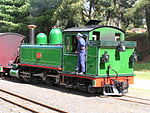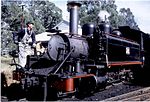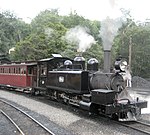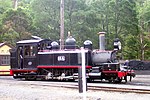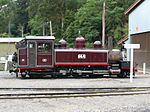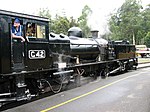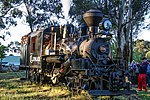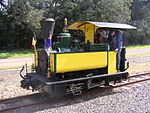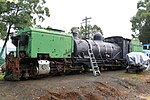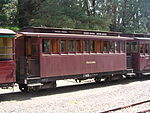|
Puffing Billy Railway
The Puffing Billy Railway is a 2 ft 6 in (762 mm) narrow gauge heritage railway in the southern foothills of the Dandenong Ranges in Melbourne, Australia. The railway was one of the five narrow gauge lines of the Victorian Railways which opened around the beginning of the 20th century. It is close to the city of Melbourne and is one of the most popular steam heritage railways in the world,[1] attracting tourists from Australia and overseas. The railway aims to preserve and restore the line and its operation as closely as possible to the way it was in the first three decades of its existence, but with particular emphasis on the early 1920s. The starting point of the railway is Belgrave station which houses the railway's operations and administration centre. The line runs through Lakeside Station where a visitor information centre provides catering and an indoor interpretive space,[2] and terminates at Gembrook railway station. In 2022, passengers were allowed to resume the popular practice of sitting on the window ledges of carriages with their legs dangling outside,[3] which had become a core part of the charm of the railway. History The original line was opened in 1900 to serve the local farming and timber community. It ran to Gembrook from Upper Ferntree Gully station, which was the terminus of the broad gauge line from Melbourne. The section of the line from Upper Ferntree Gully to Belgrave was rebuilt to 5 ft 3 in (1,600 mm) gauge between 1958 and 1962 and is now operated by Metro Trains Melbourne suburban electric trains. [4] The railway had attracted a number of colloquial names locally before Puffing Billy became the dominant one. Services stopped in 1953 after a landslide blocked the line between Selby and Menzies Creek, and it was formally closed in 1954.[5] At the end of 1954, the Victorian Railways sought to minimise their financial risks if the railway was to reopen. Harold L. Hewett, a teacher at Melbourne Grammar School, organised a rally attended by 400 people at Upper Ferntree Gully station on 4 January 1955 to try to save the railway. PreservationFollowing closure, a few farewell specials operated on the remaining usable section to Belgrave, and these proved very popular. On 1 October 1955, the Puffing Billy Preservation Society was formed to keep the railway running indefinitely. They operated trains to Belgrave until 1958 when services again ceased for conversion to a broad-gauge, electrified suburban line. The society started work on restoring the Belgrave to Lakeside section. Rover Scouts attending the 7th World Rover Moot held at Wonga Park assisted in the clearing of the line between Belgrave and Menzies Creek as part of the event's community service component.[6] On 28 July 1962 trains resumed running between Belgrave and Menzies Creek.[7] Operations were extended over the remainder of the original line, opening to Emerald on 31 July 1965 and Lakeside on 18 October 1975 before reaching Gembrook, which was opened on 18 October 1998. The first trains to Gembrook carried children from the primary schools along the Belgrave–Gembrook corridor, two of which directly adjoin the railway and the remainder not more than a street away. [8][9][10] The railway operates daily (except for Christmas day) between Belgrave and Lakeside, with services to Gembrook on Sundays. Its infrastructure is restored and recreated to reflect the heyday of the line between 1900 and 1930, and is operated with some of the railway practices from the Victorian Railways of that era, such as using the "Staff and Ticket" safeworking system. In the 2016/17 financial year, Puffing Billy carried 487,237 passengers, up more than 60,000 from the previous financial year.[citation needed] Structure  When the Puffing Billy Preservation Society was formed in 1955, the line was still under the control and ownership of the Victorian Railways (V.R.).[11] The society arranged for the V.R. to run the train on weekends and holidays, with the Society guaranteeing the V.R. against losses from insufficient ticket sales. Society volunteers took the role of conductors, checking tickets on the train, and fund-raising. That arrangement continued until the Upper Ferntree Gully to Belgrave section of the line was closed in 1958. When the line reopened in 1962, between Belgrave and Menzies Creek, society volunteers took a larger role, staffing stations, selling and checking tickets, doing non-safety-critical maintenance on the train, and track maintenance under the supervision of a V.R. ganger. Ticket revenue went into an account on which the V.R. drew to pay its staff involved in running the line.[12][13] The V. R. was not in the preservation or tourism business, and the arrangement was less than ideal, so the Victorian Government passed the Emerald Tourist Railway Act 1977 (No. 9020), which set up the Emerald Tourist Railway Board (ETRB) as a statutory authority to take over ownership and operation of the railway from the V. R. after 1 October 1977.[14][15] The act required that the Board have between five and ten members, four of whom were to be nominated by the Puffing Billy Preservation Society. The ETRB was defined as the operator of the Railway, with the Puffing Billy Preservation Society providing the volunteer support. All volunteers on the railway were directly engaged by the ETRB and were required to register and complete a range of induction processes. The railway still relied heavily on the volunteers, who welcome guests from all parts of the world and are highly trained to supply the safe and successful operation of the railway.[16] There are many roles required to operate a heritage steam railway in compliance with modern obligastions. They include signalmen, guards, firemen, engine cleaners, drivers, track patrollers, fire patrollers, safeworkers, station-masters, conductors, booking clerks, refreshment staff, gardeners, maintenance workers, researchers, and administration. Staff also operate across management, finance, human relations (HR), Occupational Health and Safety (OH&S), child safety, workshops, way and works, and operational staff who support the volunteer roles. In 2022, the Emerald Tourist Railway Act 1977 was replaced by the Puffing Billy Railway Act 2022. That move was partly influenced by the recommendations in the 2018 report by the Victorian Ombudsman on the activities of child sex offender Robert Whitehead at the Puffing Billy Railway and other Victorian heritage railway organisations.[17] The new act replaced the ETRB with the Puffing Billy Railway Board, the role of which was "to operate, manage and maintain the infrastructure and assets of the Puffing Billy Railway".[18] The running of trains services remained largely in the hands of volunteers organised by the Puffing Billy Preservation Society, and they continue to be at the core of the day-to-day operation of the railway.[19] Operation The main offices of the railway are at Belgrave, along with the locomotive running shed and locomotive workshops, and track maintenance operations. Other offices are located at Emerald). Trains from Belgrave generally travel to Lakeside, with some services extended to Gembrook. The railway operates every day of the year except Christmas Day. The train has a maximum operating speed of 24 km/h (15 mph),[20] with its average speed being 16 km/h (10 mph).[21] A popular feature of a ride on Puffing Billy was sitting on the ledge of the open-sided carriages. After a crash between a train and a minibus at the Menzies Creek level crossing on 5 March 2018,[22] this practice was suspended. The suspension was permanently lifted on 4 February 2022.[23] There is a narrow-gauge railway museum at Menzies Creek station, which reopened in March 2022 after re-development.[24][25] It is open on Friday, Saturday and Sunday. ScandalIn 2014, Robert Whitehead, a long-serving volunteer on the railway, was convicted of multiple sexual offences against young boys. He died in prison in 2015 while serving a sentence of more than 8 years.[26] Whitehead had been convicted and jailed in 1959 for molesting a boy scout, but he returned to his job on the railways at the request of Murray Porter, a state government minister. He joined the Puffing Billy Railway as a volunteer in 1961[27] and rose to become Secretary of the Puffing Billy Preservation Society. He used his position to meet and molest boys into the 1990s.[28] In 2018, the ombudsman's report on the case found that the board of the railway had known about Whitehead's activities and had actively protected him.[27] Significant changes have occurred at the railway since the Ombudsman Report that includes implementing the recommendations and supporting an open and transparent complaints and feedback process. In 2022, a new Victorian Parliament Act was passed that replaced the Emerald Tourist Railway Board with the Puffing Billy Railway Board.[29] The Act modernised the governance of the railway which was noted by the Ombudsman to have failed. Locomotives and rolling stockLocomotives  The railway owns all the surviving Victorian Railways narrow-gauge locomotives and has restored all but one to operating condition, although not all are running at any one time. This includes 2-6-2T NA class locomotives 3A (unrestored), 6A, 7A, 8A, 12A and 14A, and G class Garratt locomotive G42. In December 2019 NG G16 Garratt locomotive 129 imported from South Africa entered service. It had been purchased in 1996, and was rebuilt and re-gauged for the Puffing Billy. It complements the operational capabilities of G42. The NA class locomotives are limited to pulling a maximum of 12 carriages, while the Garratts can haul up to 18. The railway has a number of smaller steam locomotives at museum at Menzies Creek, either on static display or in operating condition. These include a Peckett 0-4-0ST, 2 Decauvilles (one is a 0-4-0T, and the other a 2-4-2ST) both from the West Melbourne Gasworks, and a Climax geared locomotive from the Tyers Valley Tramway. They occasionally operate special trains and at events such as Thomas the Tank Engine days. Puffing Billy Railway also offers driver experience days on the smaller steam engines. The Climax engine has been restored for this purpose as it has a large driving cab and is unique in Australia. The railway operates three diesel locomotives which are used on days of total fire ban, plant or works trains, or when too few steam locomotives are available, including in emergencies. D21 is former Tasmanian Government Railways V class V12, while DH5 and DH59 are ex Queensland Railways DH class. All were regauged and rebuilt for the railway.[30] Diesel Rail Tractor (NRT 1) is mainly used for shunting rolling stock at the carriage workshops. VR Original
Other steam
CarriagesThe mainstay of the carriage fleet are the 15 NBH open-sided carriages built specially for tourist traffic on the Gembrook line by the V.R. between 1918 and 1919, and a further 10 vehicles built to the same or similar design in the preservation era.[36] However, there are also a number of enclosed carriages, both saloon and compartment cars. In addition, four carriages were obtained from the Mount Lyell Railway in Tasmania after its closure in 1963, and regauged and reclassified for Puffing Billy use, numbered 1 to 4 NBL. They are named Mt Lyell, Rinadeena, Teepookana, and Dubbil Barril respectively, reflecting their Tasmanian heritage. During the 1980s and 1990s they were all upgraded to first class carriages, recoded 1 to 4 NAL, and are now primarily used on the Luncheon train and Dinner trains. Several carriages have been temporarily converted to include a guard's compartment. A number of NQR low-sided goods trucks have also been modified for passenger use, making them similar to the NBH carriages. Another three NQR trucks have been fitted with seats but no roof and are only used during the summer peak season.
Goods vehicles and brake vansRepresentatives of all classes of goods vehicles and brake vans (including combined brake van and passenger carriage) used on the narrow gauge lines of the Victorian Railways are to be found on the Puffing Billy line, and are used for works trains, storage, and occasional heritage trains recreating the look of trains in the 1920s. In popular cultureSolo One was a TV police drama series produced by Crawford Productions that screened in 1976, filmed and set in Emerald, Victoria, about a local (fictional) policeman dealing with crime in the town, however it was aimed at a younger audience than most Australian TV police dramas. It featured Puffing Billy in the opening credits scene as well as being part of most story-lines. The ABC children's drama Come Midnight Monday [37] was filmed in and around Belgrave, Emerald & Cockatoo and featuring Puffing Billy locomotive 12A—renamed "Wombat"—as the main character. Filming of A Country Practice in the fictional town of Wandin Valley (the towns of Wandin, Wandin North and Wandin East are however 30 km north of Emerald) was moved to Emerald when the show moved to Network 10, and occasionally featured Puffing Billy. The 1966 television special The Seekers at Home filmed a segment at Puffing Billy, where The Seekers sing "Morningtown Ride" to a group of children.[38] Filming of Round the Twist was in and around Belgrave to Lakeside. In 1997, the soap opera Neighbours filmed scenes set on and around the train. The characters of Darren Stark and Libby Kennedy lost young Louise Carpenter and chased after the train en route to Belgrave on a motorbike to catch up with her after discovering she had boarded it. Line guide
Regular Puffing Billy services usually only stop at stations shown in bold print at the right. Stops at other stations can be made by request. Distances are from Southern Cross station. Bibliography
References
External linksWikimedia Commons has media related to Puffing Billy Railway, Melbourne. |
|||||||||||||||||||||||||||||||||||||||||||||||||||||||||||||||||||||||||||||||||||||||||||||||||||||||||||||||||||||||||||||||||||||||||||||||||||||||||||||||||||||||||||||||||||||||||||||||||||||||||||||||||||||||||||||||||||||||||||||||||||||||||||||||||||||||||||||||||||||||||||||||||||||||||||||||||||||||||||||||||||||||||||||||||||||||||||||||||||||||||||||||||||||||||||||||||||||||||||||||||||||||||||||||||||||||||||||||||||||||||||||||||||||||||||||||||||||||||||||||||||||||||||||||||||||||||||||||||||||||||||||||||||||||||||||||||||||||||||||||||||||||||||||||||||||||||||||||||



